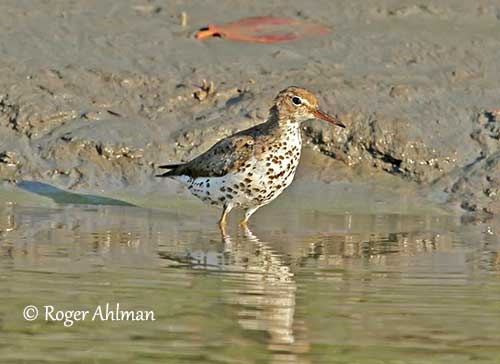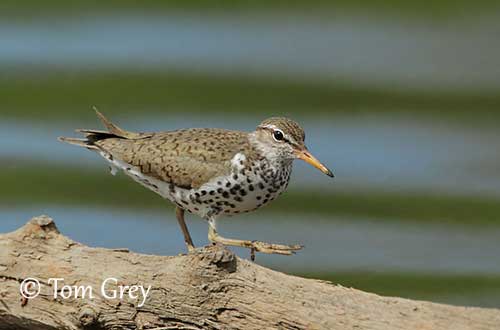
Fr: Chevalier grivelé
Ang: Spotted Sandpiper
All: Drosseluferläufer
Esp: Andarríos Maculado
Ita: Piro piro macchiato
Nd: Amerikaanse Oeverloper
Sd: fläckdrillsnäppa
Photographers:
Roger Ahlman
Pbase Galleries Peru and Ecuador
Tom Grey
Tom Grey's Bird Pictures & Tom Grey's Bird Pictures 2
Text by Nicole Bouglouan
Sources:
HANDBOOK OF THE BIRDS OF THE WORLD Vol 3 by Josep del Hoyo-Andrew Elliott-Jordi Sargatal - Lynx Edicions - ISBN : 8487334202
SHOREBIRDS by Peter Hayman, John Marchant and Tony Prater – Christopher Helm – 1986 – ISBN: 0747014035
THE HANDBOOK OF BIRD IDENTIFICATION FOR EUROPE AND THE WESTERN PALEARCTIC by Mark Beaman, Steve Madge - C. Helm - ISBN: 0713639601
FIELD GUIDE TO THE BIRDS OF NORTH AMERICA - National Geographic Society -ISBN: 0792274512
GUIDE DES LIMICOLES de D. Taylor - Delachaux et Niestlé - ISBN : 2603014080
A GUIDE TO THE BIRDS OF MEXICO AND NORTHERN CENTRAL AMERICA by Steve N. G. Howell, Sophie Webb - Oxford University Press - ISBN: 0198540124
A GUIDE TO THE BIRDS OF COLOMBIA by Steven L. Hilty and William L. Brown - Princeton University Press – ISBN 069108372X
All About Birds (Cornell Lab of Ornithology)
The Birds of North America online
Animal Diversity Web (University of Michigan Museum of Zoology)
Bird Web (Seattle Audubon Society)
Neotropical Birds – Cornell Lab of Ornithology
What Bird-The ultimate Bird Guide (Mitchell Waite)
Polyandry in the Spotted Sandpiper
Spotted Sandpiper
Actitis macularius
Charadriiformes Order – Scolopacidae Family
INTRODUCTION:
The Spotted Sandpiper is a widespread wader in North America, highly distinctive by its thrush-like dark spotting on the white underparts in breeding plumage. Its curious jerky flight is similar to that of its close relative the Common Sandpiper.
But the Spotted Sandpiper also differs by its unusual breeding system. The polyandrous females arrive first on the breeding grounds, and as soon as the males appear, the females display, compete for males, fight and defend territories. The males incubate the eggs and rear the young alone, while the females mate with other males. This reproductive strategy is usually highly successful.
The Spotted Sandpiper breeds in North America and winters S through Central America, West Indies and most of South America.
The species is widely distributed throughout the range, and the population is currently not globally threatened, in spite of slow decline.

DESCRIPTION OF THE BIRD:
Biometrics:
Length: 18-20 cm
Wingspan: 37-40 cm
Weight: 64 g
The Spotted Sandpiper adult in breeding plumage has white underparts showing unique dark-spotted pattern, especially on breast and belly. This spotting is variable, and generally, the female has larger and darker spots. The underwing pattern is similar to that of Common Sandpiper, with uniformly white axillaries.
The upperparts are olive-brown with distinct dark barring. There is a conspicuous white wingbar on the upperwing, mostly visible in flight. The wingbar runs across the outer secondaries and the inner primaries. We can see a white trailing edge on the inner secondaries. On the tail, the outer rectrices have whitish outer edges.
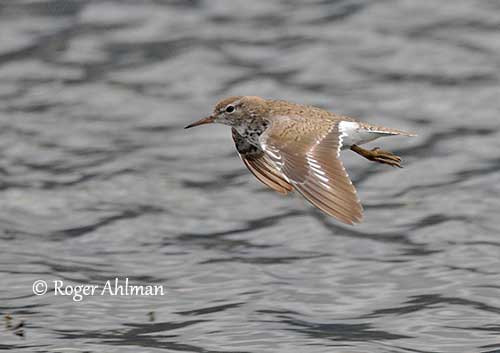
On the head, forehead, crown, nape and hindneck are olive-brown. There is a white supercilium contrasting with a dark brown eye stripe. Chin and throat are white with dark spots.
The short, straight bill is dark brown with orange or pinkish base and black tip. The eyes are dark brown, surrounded by narrow, white eyering. Legs and feet are dull pinkish-brown.
The female is similar but with larger and darker spots in breeding plumage. She is slightly larger than male.
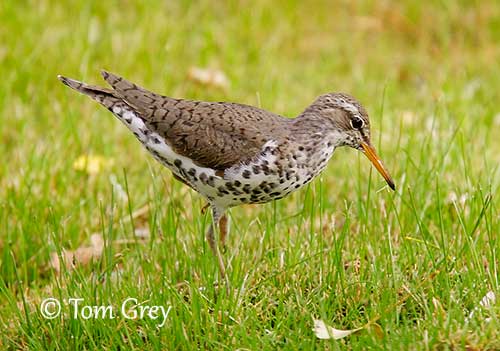
The non-breeding adult shows less conspicuous shaft-streaks and barring on upperparts. On the white underparts, the sides of the breast have grey-brown patches. In fresh plumage, the wing-coverts have narrow, pale buff tips.
The bill is duller with dull greenish or brownish base. Legs and feet vary from greyish-olive to dull yellow.
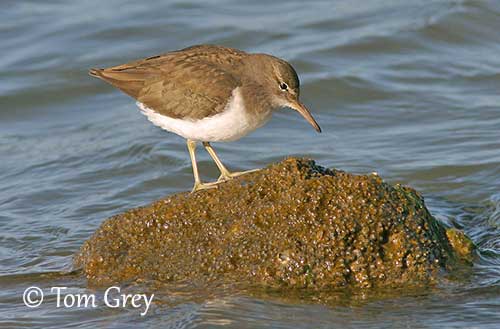
The juvenile resembles non-breeding adult, but the upperparts are greyish with narrow buff fringes, and the wing-coverts are strongly barred brown at tip.
RANGE:
The Spotted Sandpiper breeds in North America, from Alaska across Canada to Newfoundland, S to SC California, E Arizona and W New Mexico, and then E to N Carolina.
It winters from S USA through Central America and West Indies to South America, S to N Argentina and C Chile. It reaches sometimes the Galapagos Islands.
This species is regarded as monotypic. However, the western birds “A.m. rava” are greyer and less glossy above, and with heavier and blacker spotting below. But currently, this subspecies is not recognized.
HABITAT:
The Spotted Sandpiper breeds at the edge of fresh water such as lakes, ponds, rivers and streams, both in open and wooded country. On migration and during winter, it frequents the seashores and can be seen along coast on mudflats and beaches, lagoons and mangroves.
This species breeds from sea-level up to 4700 metres of elevation. It has been recorded up to 4100 metres in Peruvian Andes in winter.
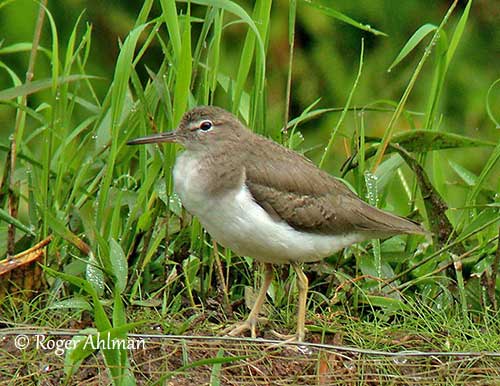
CALLS AND SONGS: SOUNDS BY XENO-CANTO
The Spotted Sandpiper in flight gives a series of slightly rising “peet” notes. It also produces a flat, double “teet-teet” or a stronger “tueet-ueet”. The alarm call given in flight or from the ground is a “weet-weet” and “peet-peet-peet”, becoming an extended series when the bird is flushed “tweet-weet-tweet-weet…”
BEHAVIOUR IN THE WILD:
The Spotted Sandpiper feeds on both aquatic and terrestrial insects and other invertebrates, crustaceans, crabs, crayfish, earthworms, small fish and molluscs, and sometimes carrion.
It forages in several ways, by picking up food from water surface or ground, by snatching flying insects or by plucking small items from shallow water.
It may sometimes crouch low on open flats, stalk slowly and then, dash forwards to catch the prey. On the ground, it nods and teeters constantly.
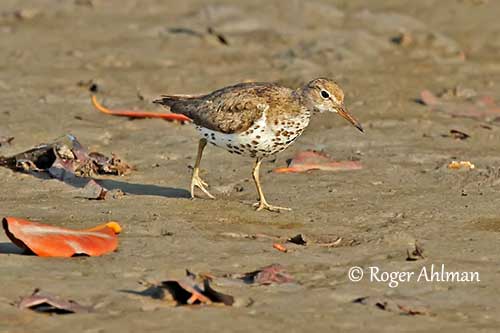
In this species, the sex roles are reversed and the female is larger and socially dominant. She is aggressive and defends strongly the breeding territory, both in flight and on the ground.
The breeding period is influenced by insect abundance, and often stops abruptly in early July, prior to the decline of insect populations.
Once arrived on the breeding grounds, the females display and compete for males. During the aerial display, the female pursues the male, often low over water and at great speed interspersed with glides on arched wings. The females may fight sometimes, involving physical contact.
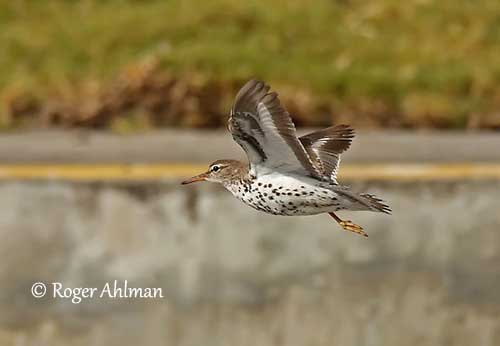
They often mate with several males through the season, and may produce up to five clutches of 4 eggs each. But usually, they lay 2-3 clutches during the short breeding season of 6-7 weeks.
The male incubates the eggs and tends the young alone, while the female defends the territory and mates with other males. This reproductive system is usually highly successful.
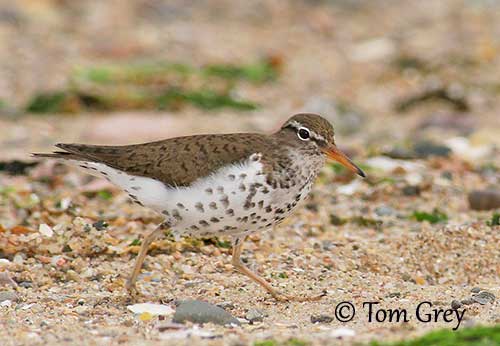
The Spotted Sandpiper is migratory. The females leave first, then the males followed by the juveniles. They often migrate singly, but the species moves in broad front across North America. The return migration from South America probably follows an interior route through USA. Vagrants are recorded in Europe (Britain, Finland, Bulgaria and Turkey), also in North Africa and sub-Saharan Africa (Kenya, Cameroon and Senegal), also E Asia, Hawaii and some Pacific islands.
The Spotted Sandpiper flies with stiff, rapid, fluttering wingbeats. The jerky flight is direct, low over water.
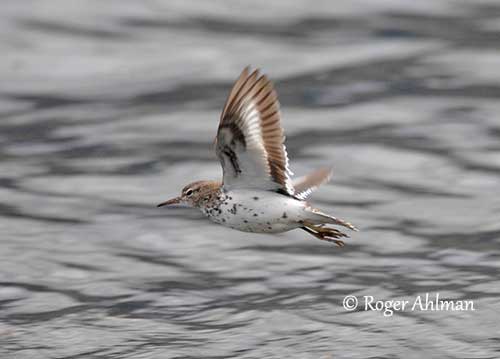
REPRODUCTION OF THIS SPECIES:
The laying takes place mid-May to June. The Spotted Sandpiper nests on the ground in sparse vegetation, in a shallow depression made by both adults and lined with grass, moss and sometimes feathers. Each “pair” produces a single brood per season.
The female lays 4 buff eggs with brown markings. The male incubates alone during 20-24 days, while the female mates with other males. She can keep the sperm for a month, which does not guarantee any legitimate paternity to the different mates. However, she will take part in incubation of the latest clutch of the season.
At hatching, the chicks are dull grey above with black eyeline, and mid-line on crown and back. The underparts are white. They leave the nest soon after hatching, and are able to feed themselves, tended by the male. They fledge about 17-21 days after hatching.
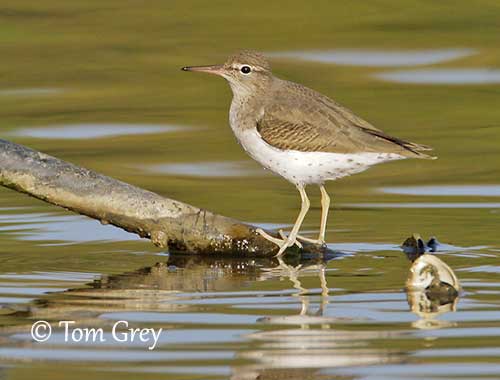
PROTECTION / THREATS / STATUS:
The Spotted Sandpiper is widely distributed in North America. The global population is estimated at 640,000 individuals, and this population is slightly declining. But currently, the Spotted Sandpiper is evaluated as Least Concern.
